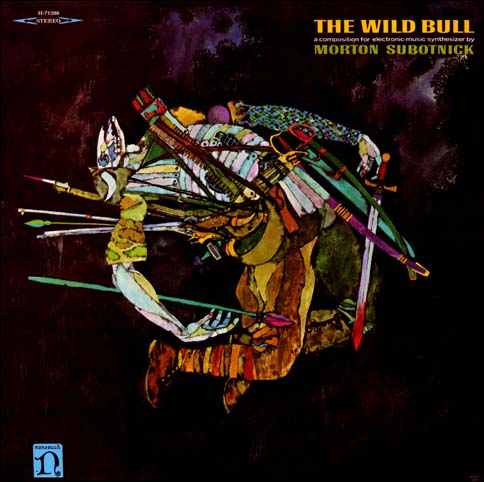
Morton Subotnick – 1968 – The Wild Bull
Quality: 5 out of 5
Trip O Meter: 5 out of 5
A year after “Silver Apples Of The Moon,” Morton Subotnick and his trusty Buchla synthesizer returned with “The Wild Bull.” Really, to completely understand this stuff, it may be best to get a view of the Buchla:
Morton Subotnick was born April 14, 1933 in Los Angeles, California. He earned his undergraduate degree in English Literature from the University of Denver and his Master of Arts in Composition from Mills College, where he studied with Leon Kirchner and Darius Milhaud. While in California, Subotnick co-founded the Mills College Performing group and the San Francisco TGape Music Center. At this same time he held posts as Assistant Professor of Music at Mills College and Musical Director of Ann Halprin’s Dancers’ Workshop Company.
Since 1960 Morton Subotnick has been working with tape, and his present involvement with mixed media includes the theatrical. He was Musical Director of the Repertory Theatre at New York;s Lincoln Center during its first season, and since the Falls of 1966 has been involved with the Intermedia Program at the School of Arts at New York University (The purpose of this program is to bring together artists who specialize in various media – film, theater, tape, etc.) Subotnick is also Director of Electronic Music at the Electronic Circus.
Prominent among his electronic-music works is Silver Apples of the Moon, composed in 1967 for Nonesuch records on a commission from Nonesuch directed specifically to the LP record medium – the first in Nonesuch’s continuing commission series. Both Silver Apples and the Wild Bull (also a Nonesuch commission) were composed on the modular electronic music system originally built for Morton Subotnick by Donald Buchla at the San Francisco Tape Music Center.
“The first side of this record was almost complete when I came across ‘The Wild Bull’. I was very impressed by the poem and quickly began to feel an affinity between the poem and the composition I was working on…in fact the first three notes of the work seemed to me a kind of human / wild-bull moan…and later I added a human breathing sound to one of the noes.
there was never an attempt to ‘portray’ the poem (I don’t think music is about that}, but at the same time it became harder and harder to disassociate myself from the pathos and restrained cry of personal loss which spoke to me from such a distant point in time The state of mind which the poem evoked became intimately tangled with the state of mind my own composition was evoking in me. To title the work after the poem seemed natural and to offer the poem seems equally natural.” – Morton Subotnick
Although the same set of sonic tools are at work on this album, the aural picture is very different.
Bringing the sound down to earth, Subotnick focuses less on the seemingly random pings and bleeps that formed the backbone of “Silver Apples.” Side A of “The Wild Bull” builds on roaring background oscillators, until the bull finally begins to rise. Here, we find Subotnick focusing more on melody as the bull gets a sort of melodic theme from a fuzzed-out oscillator.
Side B sounds even more progressive with the bleating Buchla forming what could almost be mistaken for a modern IDM rhythm as the ominous, synthesized tones of the bullring wail in the background. The fight ensues as the bulls theme returns, violently rolling around with the rhythm, and finally the bullring returns with its own roar. It’s amazing that such a colorful story could emanate from such a primitive machine. I suppose that’s a big part of Subotnick’s genius.
“Silver Apples” is the electronic breakthrough, but “The Wild Bull” refines and even perfects the alien tones of the Buchla. It’s a very listenable piece for what it is and is sure to take your mind on an interesting sonic journey.
